Mary Anne Yarde's Blog: The Coffee Pot Book Club , page 201
July 19, 2017
The Island of Glass ~#FolkloreThursday #Myths #Legends #England
Joseph of Arimathea stood on Golgotha Hill and watched, with a broken heart, as Jesus died on a wooden cross. When they finally lowered Jesus from the cross, Joseph felt compelled to offer Jesus' family the use of his tomb, so that they had somewhere to lay Jesus' broken body. It is hard to imagine what was going on in Joseph's mind that day. To give up his grave was no small thing, but his love for Jesus and for what he stood for, meant more to him than his final resting place.

But then a miracle happened, and Jesus rose from the dead. The tomb was again empty, but Joseph's heart was full of wonder. He became a disciple and spent the rest of his life wandering the world and passing on the teachings of Jesus.
 Joseph of Arimathea by Pietro Perugino, a detail from his Lamentation over the Dead Christ.
Joseph of Arimathea by Pietro Perugino, a detail from his Lamentation over the Dead Christ.It came to pass that Joseph and a group of friends sailed to a distant land called Albion. They followed the River Severn as they travelled inland and finally they found themselves in The Summer Lands.
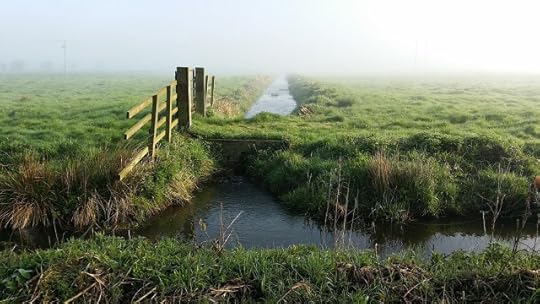 The Somerset Levels ( The Summer Lands)
The Somerset Levels ( The Summer Lands)The Summer Lands were only accessible during the summer months for grazing cattle and sheep. In the winter the water would reclaim the land and all that would be left was a very large hill, seemingly floating in the middle of this great flood. The water reflected the hill and because of this the Celts called this place Ynys Witrin —The Isle of Glass.

Joseph and his friends climbed one of the smaller hills that surrounded the largest hill. Joseph lent heavily upon his thorn-wood staff, as he tried to catch his breath from the climb. He decided to name the hill, Weary-A-Hill. Joseph thrust his staff into the damp earth and then sat down to rest.
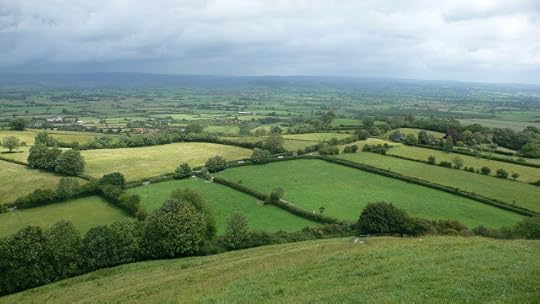 The view from Glastonbury Tor
The view from Glastonbury TorThat night an angel visited Joseph in his dreams. The angel told Joseph that this land was his future. It would be his new home.
Joseph awoke, refreshed, as did his friends, but much to their surprise the staff had taken root. New shoots shot out from the once smooth wood. Theses shoots would soon grow into strong branches. The buds of leaves were already forming. This was a miracle. This was a gift from God. There was no doubt in Joseph's mind.

Weary-A-Hill was owned by a rich nobleman who had no time for the stories of this Christian deity. Neither did he have any use for the hill, for it was too steep to farm. In a gesture of goodwill, he told Joseph he could build on the hill if he so desired.
Joseph took the nobleman up on his offer and build he did. But it wasn't a house for himself — it was a house for God. He built a House Of Worship. In fact, it was the first Christian Church ever to be built.
And then people started to come. At first, the odd few stranger turned up, but people were drawn here, answering a silent call. Soon Joseph had a healthy congregation, and yet, still more people came.
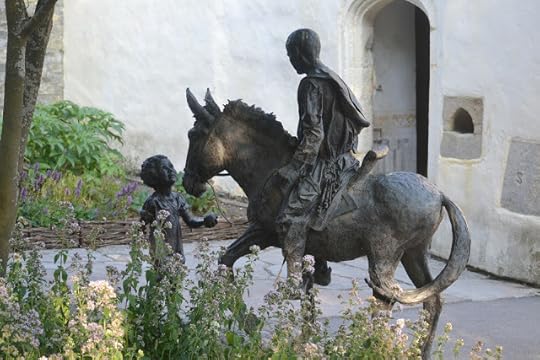 A Pilgrim on his way to Glastonbury
A Pilgrim on his way to GlastonburyThe Angel had been right. Joseph had found his home in what was once a strangely foreign place. He had no need for his tomb that he had given up for Jesus all those years ago. It was said that Joseph was buried on the Hill, although the exact location will forever remain a mystery. The church that Joseph built was rebuilt over the centuries. Times changed, but one thing has always remained constant and that is the Thorn tree. As regular as clockwork, the thorn blossoms every year at Easter and Christmas.
Many traveled to see this miracle tree. Many compared it to Jesus' Crown of Thorns.
The Island of Glass, a forgotten name for a kingdom that inspired many legends. In the years that followed the name would change and it would become known as the Isle of Avalon.

This isn't the end of the story, far from it. Joseph's staff was not the only thing he brought with him from the Holy Lands. It was rumoured that he also brought with him a vessel. A precious cup. A beautiful Grail. But that story is for another day!
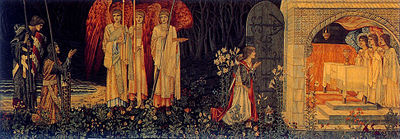 Galahad, Bors and Percival achieve the Grail. Tapestry woven by Morris & Co ~ Wikipedia
Galahad, Bors and Percival achieve the Grail. Tapestry woven by Morris & Co ~ Wikipedia***
If you fancy finding out what happened after the death of King Arthur then why not check out my historical fantasy series — The Du Lac Chronicles...
 Amazon US
Amazon USAmazon UK
Read for free with

Published on July 19, 2017 23:00
Author’s Inspiration ~ Sarah Dahl #Historical #Romance #Viking @sarahdahl13
Please give a warm Coffee Pot welcome to Historical Romance author, Sarah Dahl. Sarah is going to share the inspiration behind her fabulous story collection…
The Current: A Battle of Seduction (A Tales of Freya short story)

The "Tales of Freya" is a collection of sensual short stories set in the Viking age –and it opens with "The Current – A Battle of Seduction"!
Viking warrior Aldaith meets his real match only after the battle:
Marked from the latest battle, Aldaith wants to recover by a stream. But instead of finding solitude, he stumbles on the fearless shield maiden Nyssa. The fierce beauty invites Aldaith into the water to engage in a very different kind of battle -- one for which his training leaves him unprepared.
"Sarah Dahl brings a crisp, contemporary voice to an ages-old world of battle, bloodshed and primal indulgences. Her refreshing style not only draws the reader back into ancient times; it brings the characters to us, allowing us to meet in the middle for a vibrant and accessible experience.From two ravaged warriors reaping the spoils of war to the sensuality of a medieval menage, Ms. Dahl has a way of making scars sexy and luring out the vulnerability in the invulnerable." J.D. Lexx, author of The Crimson Confessions
"With her unique writing style and in-depth knowledge of this bygone era, she brings the world of clashing swords, dashing warriors, and strong, independent shield maidens to life.Brutality turns into sensuality in an instant, leaving the reader satisfied, yet craving more. Her writing is addictive, and every story in this brand new and exciting series is sure to thrill and delight."Elaine Coetzee, author of Runo's Curse
"A clever concept, focusing not on the chieftains and knights, but the very people battling to love and survive. Very naughty in concept, steam and steel meet in harmony in the imagination." Chris Cherry, author of the Bestselling Love and War novels
Author’s Inspiration
I've always been drawn "north". To the harsher climates and rougher landscapes. I'd rather holiday on the stormy, grey Faroer islands than some Mediterranean beach. Looking back, I've always spent my time travelling to where the Vikings went. From Norway to Ireland and Brittany, from Denmark to England and Scotland. Always favouring the rough Atlantic coast over some mild, but boring seascape. These countries' Celtic and Viking heritage fascinates me. Give me timeless, awe-inspiring forces of nature, and I'm happy.
When studying English linguistics and Geography, I did my final exams about glaciers and natural disasters. Again preferring the stark landscapes of fjords, forests and snowcapped mountain peaks to something sweeter, more harmless.
Maybe that's because I myself wouldn't be described as sweet, exactly. I'm a shield maiden at heart, and in my writing combine the two: strong, independent women in equally challenging landscapes and situations.
The more I immersed myself in the history and culture of the ancient Scandinavians, the more I was fascinated. Their early medieval societies were multifaceted and rich in culture. Women had a say in most aspects. They ruled the house. They could become healers or even warriors. They travelled with their men to settle in new lands. And "the" Vikings weren't filthy, ruthless plunderers. They were well-groomed farmers become part-time warriors, or young men seeking honour in battle and by raids. They wouldn't go out to seek rape and harming people for no reason, for that wasn’t honourable and didn’t add to their reputation at home.
Of course, things became more complex with Christianity slowly replacing the ancient mythology around the gods Odin and Thor. I prefer my stories to be set in the earlier Viking age, around 850-950, when things were still a little less politically and religiously complicated. The "raw" era fascinates me most, because: I write about the more normal people, the simpler lives. I zoom in on the more common encounters, and what these people yearn for: farmers, monks, housewives, the average warrior. I’m interested in the smaller worlds. Show average people in slightly unusual situations, which in my sensual works often turn into something sensual, steamy even. I’m interested in this often overlooked side of human lives: people's passions and dreams, the force of seduction, this game between man and woman.
So for my writing I have to soak up everything there is about my chosen era, tirelessly. I read all the books – non-fiction preferably – and try to follow new discoveries in archaeology and linguistics, for example. In a museum or on a site, I read the hard, historical facts, and then imagine what it "must have been like" for someone living in the described circumstances. One striking example is that I read that Vikings did expose their unwanted children to nature to let them die. There's an abundance of possible stories behind such a find. Out of this snippet from a text in the Viking museum at Hedeby became the flash fiction "Maelstrom" you can read for free on my website.
The German Haithabu/Hedeby Viking town and museum is my favourite place to go and immerse myself into Viking spirit, and to conjure up new story ideas (or solve older ones). Situated at the estuary of the Slien, the ages-old site is still in the original place, still embraced by the protective earthen mound's half-circle. I go there at least once a year, and their museum accompanying the site of the town is excellent. The general tranquility and relative remoteness sparks my creativity. Some of the Viking townhouses have been restored and make up a tiny settlement now, where once over 1,000 people from all over the world lived together. Standing high on the mound, face in the harsh winds and looking at the flat below, across the re-erected pier and the grey water, it's hard to imagine the bustling and what it really must have been like: living as a Viking man or woman in such an exceptional place. There were almost no towns then. Hedeby was unusual and an ongoing experiment of clashing cultures and beliefs.
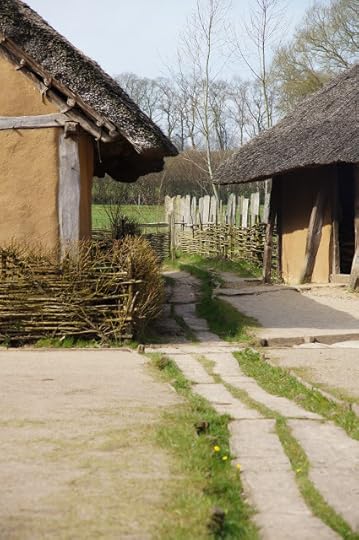
And today, the mound is still there, some of the houses revived, the landscape and sea-level fairly similar. When I arrive at the site, I steer clear of all people and wander down the wobbly plank paths alone, to duck into dark and smoky huts, or look out across the water. Just soaking up atmosphere, I walk out onto the rough pier and imagine a long row of ships of all sizes. Stalls and shouting people. The noise and stink that has long gone. With a 180-degree turn, I take in the entire landscape that must have looked similar then, although some tree species changed and agriculture – the death of Viking sites all over Scandinavia – changed some aspects forever.
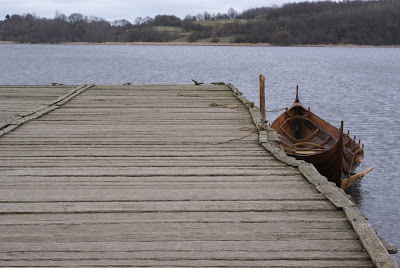
Then I always take a walk: up the mound, walking from one end to the other following that perfect half-circle, looking down on what is left and recreated of the town and harbour. I look down to the outer side, where the fields must have been, where people felled trees, and let their cattle graze. I can walk down from the mound and disappear in the light forest, circle the reedy, peaceful Haddebyer Noor, and find two runestones along the way. They, too, tell stories – and authentic ones. I can touch their rough surface and see the red runic writing, and imagine the people they talk about, and the people who erected them to commemorate Sygtrygg and Eirik.
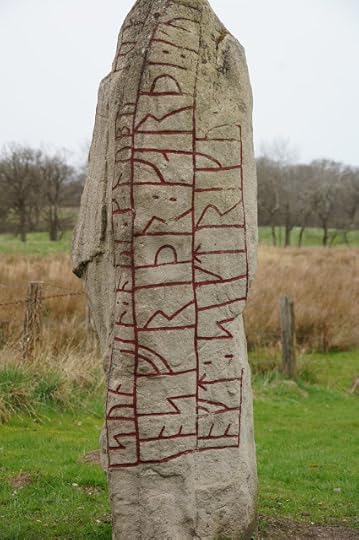
Hedeby IS stories. About people of all professions and backgrounds. They can be found in a hanging shelf, a smoke-blackened roof, under sheepskins or in the bobbing of an empty rowing boat.
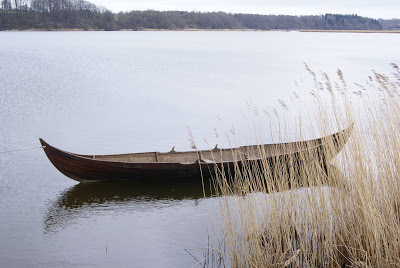
The hour-long drive home always sets my mind alight: I slowly piece together what I read and experienced; I solve story problems that at home drove me crazy, and I create new encounters. I frequently pull the car over to take notes or just close my eyes and think. When I'm home, I'm always overflowing with creativity.Hedeby is my place of inspiration, and I'll go back for as long as it talks to me like that.
Links for Purchase
Pronoun (for all major retailers)
Amazon US
Amazon UK
About the author
 Sarah Dahl lives on the edge of the rural German Eifel and writes historical fiction (novels and short stories) primarily set in the Viking age. She also works as an editor, translates, and coaches new writers in German and English. She is interested in everyday life in bygone centuries and the human stories that may have occurred behind the hard, historical facts. Her author page is: sarah-dahl.com
Sarah Dahl lives on the edge of the rural German Eifel and writes historical fiction (novels and short stories) primarily set in the Viking age. She also works as an editor, translates, and coaches new writers in German and English. She is interested in everyday life in bygone centuries and the human stories that may have occurred behind the hard, historical facts. Her author page is: sarah-dahl.comUseful Links Author homepage and blog Mailing list Book Alert FacebookTwitter Publisher Pronoun Goodreads Amazon.com author page Amazon.co.uk author page
The Current – A Battle of Seduction Publication date: April 24, 2017Published by: PronounSeries: Tales of FreyaGenre: Historical fiction
Published on July 19, 2017 00:00
July 17, 2017
Guest Post ~ Castles, Home and Fortress #History @Oldbrookender
Castles, Home and Fortress.Guest post by Brian Kitchen

Since childhood I have enjoyed visiting castles. There wasn’t one in the town that I was brought up in, but there was one a few miles away from where I lived. This was Tutbury Castle whose history goes back to at least Anglo-Saxon times. Following the Norman Conquest, a motte and bailey type of castle was built and the castle was given to the Ferrers family. From 1266 until the present day the castle has been the property of the Earls and Dukes of Lancaster and their descendants, the Kings and Queens of England in right of the Duchy of Lancaster.Today, most of the surviving buildings date from the 15th century, although the gateway at the north end is early 14th century. The house which is still inhabited today, is mid-18th century and incorporates some 17thcentury features. Over the years the castle has had some distinguished visitors, albeit some reluctant ones. Mary Queen of Scots was held prisoner at Tutbury Castle for a time and a brewer at nearby Burton upon Trent was a go-between for Mary and those plotting on her behalf.

King James 1, Mary’s son later visited on several occasions, the castle accommodation being improved by the replacement of an old medieval range of buildings, with new ones which became to be known as the King’s Lodging. James’ son, King Charles 1 also visited the castle several times and used the King’s Lodging when he stayed there and during the Civil War, the castle was held for him.A short, but unsuccessful siege of the castle in 1643 however, was followed by a successful one in the Spring of 1646, leading to the Castle’s surrender. One of the conditions of the surrender was that the castle should be rendered untenable and local men were employed to pull down the buildings. After the Restoration in 1662, some of the rooms of the Castle were repaired, but its days as a fortress were over. In 1751, a visitor to Tutbury described how he had witnessed the demolition of “an apartment of about three grand rooms, a floor with handsome window-cases and doors of modern Roman architecture.” Around about this time the artificial ruin on the motte was erected, so that Lord Vernon who now leased the castle, would have the view from his mansion at Sudbury improved. In 1832 the Duchy of Lancaster turned down a proposal to turn part of the castle into a local prison. Money was spent on repairs and the castle became a visitor attraction which it remains to today.
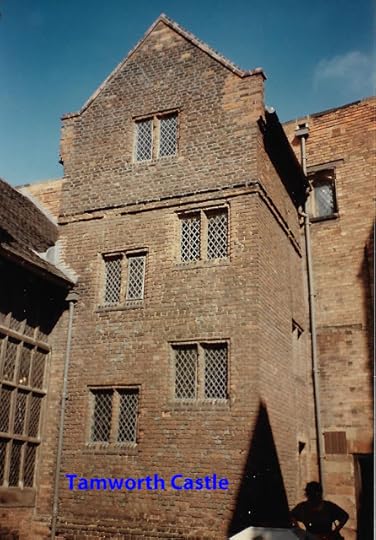
Tamworth Castle is also local to where I live and is today one of the best-preserved motte and bailey castles in England. The site of the castle served as a residence of the Mercian Kings in Anglo-Saxon times. Offa of the famous dyke (which formed the border between Mercia and Wales) built a palace there. After the Viking attack in 874ad, contemporary accounts recorded that Tamworth was left “for nearly forty years a mass of blackened ruins”. In 913ad, King Alfred’s daughter, Athelflaed, Lady of the Mercians, is known to have had Tamworth refortified and it was one of the Burghs. It was the Normans though, who built the Castle and the Marmion family, hereditary Champions of the Duke of Normandy held the Castle for six generations until 1294. It then passed to the Freville family upon Philip Marmion’s death and they held it until 1423. The Ferrers family were the next family to hold the castle. Over the centuries additions were made to the Castle, including the pictured 17th century, Jacobean three storey south range. Although the Castle came under siege in 1643 by Parliamentary forces during the English Civil War, it survived and fortunately didn’t suffer the fate of Tutbury Castle, being instead garrisoned by Parliament. In 1715, upon the marriage of Elizabeth Ferrers to the 5th Earl of Northampton, the Castle passed to the Compton family. For most of the 19thcentury the castle was let out to tenants, until in 1891 the castle was purchased by the then Tamworth Corporation. Today the successors of the corporation, the Tamworth Borough Council still own the castle and it is open to the public between April and September.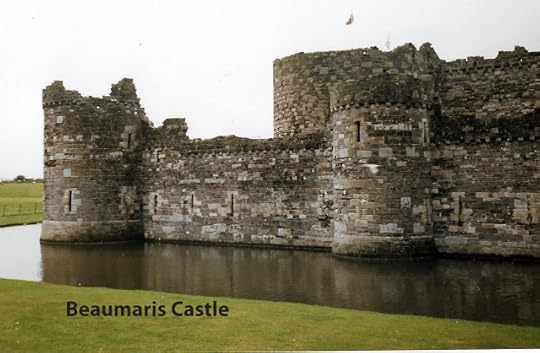
It wasn’t until later in my life that I toured the castles of North Wales, which were built to ring the coast, following the successful campaign of Edward 1 to conquer the Welsh. Beaumaris Castle, on the Isle of Anglesey, the last of the royal castles to be built is one of my favourites. Building was commenced in April 1295. Castles are generally designed as fortified residences and this is certainly true in the case of Beaumaris Castle. At Beaumaris, all the residential accommodation was either in the Inner Ward, or in towers attached to it. Beaumaris also had more accommodation than one would normally find in a castle. This is because when work was first started on the castle it was expected that the castle would need to accommodate the Royal Court, but alas this never came to pass. Unfortunately, the money ran out and in 1331, work on the castle was halted. The front of the Llanfraes Gate was left unfinished, the great towers of the Inner Ward only reached a little above the floor level of their top storeys and the turrets were never begun.

Over the years that followed the castle fell into disrepair. In 1534, it was reported “there was scarcely a single chamber in Beaumaris castle where a man could lie dry.” Four years later all four of the castles in North Wales were reported to be, (to quote in the language of the time) “much ruynous and ferre in decay for lacke of tymely reparacons.” In 1609, Beaumaris Castle was officially classified as “utterlie decayed.” Buildings were dismantled at Beaumaris Castle sometime around the time of the Restoration in 1660. The castle experienced one more Royal occasion when in 1832 a Royal Eisteddfod was held there and her Royal Highness the Duchess of Kent and her 13-year-old daughter, the future Queen Victoria attended. Today the castle is in the care of Cadw, Welsh Historic Monuments and is open to the public. I still love visiting there today and indeed all the other castles I have visited over the years. A symbol of our islands’ martial past, or someone’s home, they all have their own magic and mystery.
Links for Purchase

Divided EmpireAmazon USAmazon UK
Dark BetrayalAmazon US Amazon UK
About the author
Brian Kitchen lives in Burton upon Trent, England and enjoys walking in the countryside, photography, reading, writing, visiting museums and historic sites & buildings and supporting Burton Albion. He first became interested in the history of Roman Britain as a child and loved the Eagle of the Ninth trilogy of novels by Rosemary Sutcliff. The first of the Flavius Vitulasius novels, Divided Empire is his first published novel.Useful LinksWebsiteFacebook

Since childhood I have enjoyed visiting castles. There wasn’t one in the town that I was brought up in, but there was one a few miles away from where I lived. This was Tutbury Castle whose history goes back to at least Anglo-Saxon times. Following the Norman Conquest, a motte and bailey type of castle was built and the castle was given to the Ferrers family. From 1266 until the present day the castle has been the property of the Earls and Dukes of Lancaster and their descendants, the Kings and Queens of England in right of the Duchy of Lancaster.Today, most of the surviving buildings date from the 15th century, although the gateway at the north end is early 14th century. The house which is still inhabited today, is mid-18th century and incorporates some 17thcentury features. Over the years the castle has had some distinguished visitors, albeit some reluctant ones. Mary Queen of Scots was held prisoner at Tutbury Castle for a time and a brewer at nearby Burton upon Trent was a go-between for Mary and those plotting on her behalf.

King James 1, Mary’s son later visited on several occasions, the castle accommodation being improved by the replacement of an old medieval range of buildings, with new ones which became to be known as the King’s Lodging. James’ son, King Charles 1 also visited the castle several times and used the King’s Lodging when he stayed there and during the Civil War, the castle was held for him.A short, but unsuccessful siege of the castle in 1643 however, was followed by a successful one in the Spring of 1646, leading to the Castle’s surrender. One of the conditions of the surrender was that the castle should be rendered untenable and local men were employed to pull down the buildings. After the Restoration in 1662, some of the rooms of the Castle were repaired, but its days as a fortress were over. In 1751, a visitor to Tutbury described how he had witnessed the demolition of “an apartment of about three grand rooms, a floor with handsome window-cases and doors of modern Roman architecture.” Around about this time the artificial ruin on the motte was erected, so that Lord Vernon who now leased the castle, would have the view from his mansion at Sudbury improved. In 1832 the Duchy of Lancaster turned down a proposal to turn part of the castle into a local prison. Money was spent on repairs and the castle became a visitor attraction which it remains to today.

Tamworth Castle is also local to where I live and is today one of the best-preserved motte and bailey castles in England. The site of the castle served as a residence of the Mercian Kings in Anglo-Saxon times. Offa of the famous dyke (which formed the border between Mercia and Wales) built a palace there. After the Viking attack in 874ad, contemporary accounts recorded that Tamworth was left “for nearly forty years a mass of blackened ruins”. In 913ad, King Alfred’s daughter, Athelflaed, Lady of the Mercians, is known to have had Tamworth refortified and it was one of the Burghs. It was the Normans though, who built the Castle and the Marmion family, hereditary Champions of the Duke of Normandy held the Castle for six generations until 1294. It then passed to the Freville family upon Philip Marmion’s death and they held it until 1423. The Ferrers family were the next family to hold the castle. Over the centuries additions were made to the Castle, including the pictured 17th century, Jacobean three storey south range. Although the Castle came under siege in 1643 by Parliamentary forces during the English Civil War, it survived and fortunately didn’t suffer the fate of Tutbury Castle, being instead garrisoned by Parliament. In 1715, upon the marriage of Elizabeth Ferrers to the 5th Earl of Northampton, the Castle passed to the Compton family. For most of the 19thcentury the castle was let out to tenants, until in 1891 the castle was purchased by the then Tamworth Corporation. Today the successors of the corporation, the Tamworth Borough Council still own the castle and it is open to the public between April and September.

It wasn’t until later in my life that I toured the castles of North Wales, which were built to ring the coast, following the successful campaign of Edward 1 to conquer the Welsh. Beaumaris Castle, on the Isle of Anglesey, the last of the royal castles to be built is one of my favourites. Building was commenced in April 1295. Castles are generally designed as fortified residences and this is certainly true in the case of Beaumaris Castle. At Beaumaris, all the residential accommodation was either in the Inner Ward, or in towers attached to it. Beaumaris also had more accommodation than one would normally find in a castle. This is because when work was first started on the castle it was expected that the castle would need to accommodate the Royal Court, but alas this never came to pass. Unfortunately, the money ran out and in 1331, work on the castle was halted. The front of the Llanfraes Gate was left unfinished, the great towers of the Inner Ward only reached a little above the floor level of their top storeys and the turrets were never begun.

Over the years that followed the castle fell into disrepair. In 1534, it was reported “there was scarcely a single chamber in Beaumaris castle where a man could lie dry.” Four years later all four of the castles in North Wales were reported to be, (to quote in the language of the time) “much ruynous and ferre in decay for lacke of tymely reparacons.” In 1609, Beaumaris Castle was officially classified as “utterlie decayed.” Buildings were dismantled at Beaumaris Castle sometime around the time of the Restoration in 1660. The castle experienced one more Royal occasion when in 1832 a Royal Eisteddfod was held there and her Royal Highness the Duchess of Kent and her 13-year-old daughter, the future Queen Victoria attended. Today the castle is in the care of Cadw, Welsh Historic Monuments and is open to the public. I still love visiting there today and indeed all the other castles I have visited over the years. A symbol of our islands’ martial past, or someone’s home, they all have their own magic and mystery.
Links for Purchase

Divided EmpireAmazon USAmazon UK
Dark BetrayalAmazon US Amazon UK
About the author

Brian Kitchen lives in Burton upon Trent, England and enjoys walking in the countryside, photography, reading, writing, visiting museums and historic sites & buildings and supporting Burton Albion. He first became interested in the history of Roman Britain as a child and loved the Eagle of the Ninth trilogy of novels by Rosemary Sutcliff. The first of the Flavius Vitulasius novels, Divided Empire is his first published novel.Useful LinksWebsiteFacebook
Published on July 17, 2017 23:00
July 16, 2017
The Bishop's Palace ~ #Wells #history #Poldark
The City of Wells is the smallest city in England.
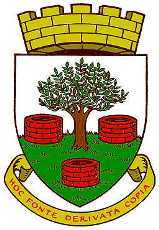
It is home to the architectural masterpiece that is the Cathedral of St Andrews.

Adjacent to the cathedral is The Bishop's Palace, which has been home to the Bishops of Bath and Wells for over 800 years.
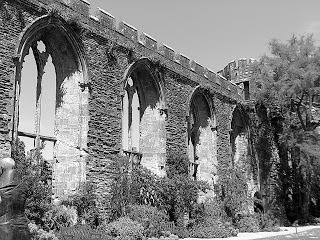
The Palace was commissioned by the first Bishop of Bath and Wells — Bishop Jocelin Trotman in c.1210. Bishop Trotman received a crown license to build a residence and a deer park on the south side of the Cathedral. Future Bishops would add to the residence, which included a chapel and a Great Hall.
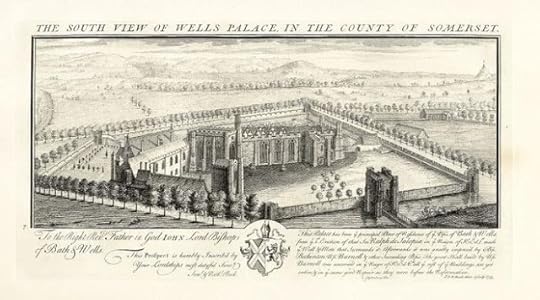
An engraving of the Bishops Palace, Wells made by Samuel and Nathaniel Buck in 1733, showing the wall and moat
In the 14th century, Bishop Ralph of Shrewsbury commissioned the building of the crenellated walls as well as the moat. Bishop Ralph of Shrewsbury had an uneasy relationship with the citizens of Wells, due to high taxes, and thus he needed his residence protected.
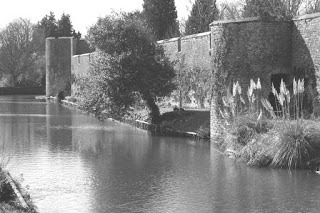 The Moat
The Moat In 1548, following the Dissolution of the Monasteries, Bishop Barrow, sold the property to Edward Seymour, 1st Duke of Somerset. The grounds were recovered after the execution of the Duke.
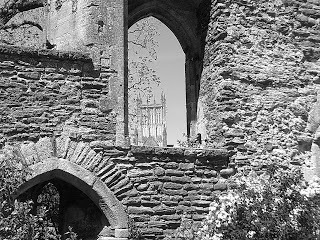
The Palace now belongs to the Church Commissioners and is managed by The Palace Trust. It is open to the public and boasts of 14 fabulous acres of gardens, where you can also find St Andrew's Spring, where Wells takes her name from.
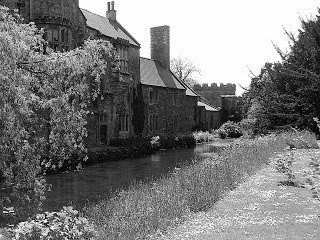
The Bishop's Palace is also a popular location for the movies and television industry. The 2007 comedy, Hot Fuzz was filmed here, as was the sequel to Snow White and The Huntsman.
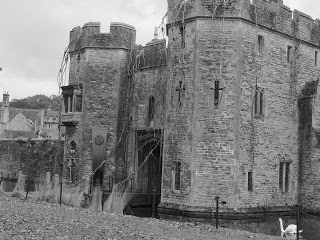
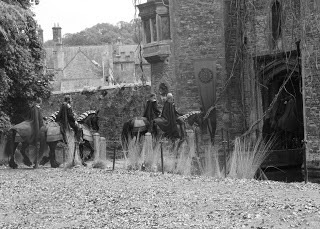
Most recently, The Bishop's Palace was transformed into a French Prison for the BBC hit series, Poldark.
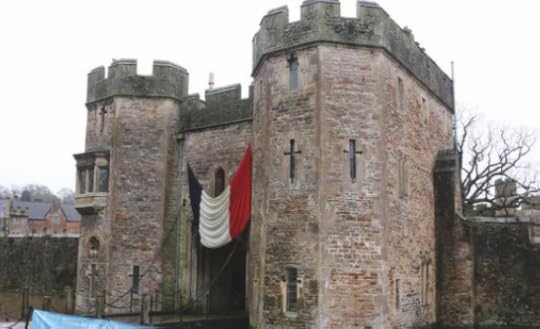
If you ever find yourself in Wells, then I highly recommend you check out this beautiful little Palace — you won't be disappointed.
Published on July 16, 2017 23:00
July 12, 2017
Sir Thomas Malory and #Arthurian #Legend ~ #kingarthur
"The hoole booke of kyng Arthur and of his noble knyghtes of the rounde table"
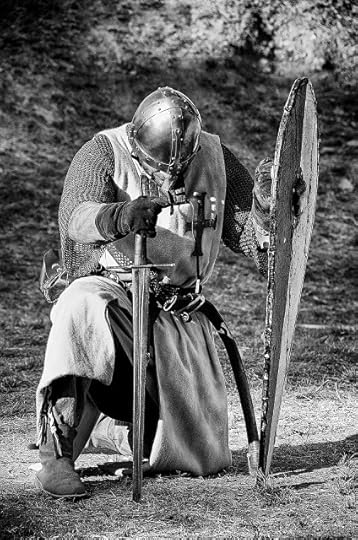
When it comes to the Great Arthurian writers, there are two names that come to mind — Geoffrey of Monmouth and Sir Thomas Malory. I have talked about Monmouth a lot recently, but I thought I would concentrate on Malory today.
Sir Thomas Malory gave us one of the greatest Arthurian works…
Le Morte d'Arthur.

Le Morte d'Arthur was first published in 1485 and is now one of the best-known works of Arthurian literature. Many of the stories that were to follow, including the works of White and Tennyson, were strongly influenced by Malory's work.
Who was Sir Thomas Malory?
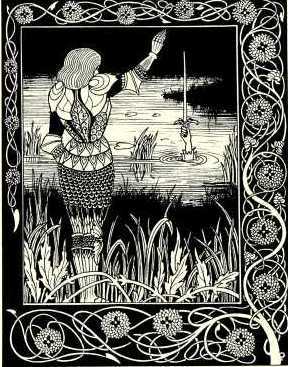 An Aubrey Beardsley illustration for Malory's Le Morte d'Arthur, "How Sir Bedivere Cast the Sword Excalibur into the Water" (1894) ~ Wikipedia
An Aubrey Beardsley illustration for Malory's Le Morte d'Arthur, "How Sir Bedivere Cast the Sword Excalibur into the Water" (1894) ~ WikipediaThat is a difficult question to answer because like King Arthur, Malory is pretty elusive. He did leave a small clue in the colophon of Le Morte d'Arthur. He called himself…
“Syr Thomas Maleore knyght.”He declares that he finished his work in the ninth year of the reign of Edward IV. He also leaves a prayer for “good delyueraunce” from prison.
The likeliest author of Le Morte d'Arthur is Thomas Malory of Newbold Revell in the parish of Monks Kirby, Warwickshire. This Sir Thomas had a rather notable career, for all the wrong reasons. He inherited his father's estate in 1434, but he didn't conform. He spent most of his life in and out of prison. His name has a long list of alleged crimes attached to it, theft, attempted murder, rape, extortion. He even escaped from Coleshill Prison, but instead of keeping a low profile, he robbed the Cistercian Monastery! He did, however, have friends in high places, for after two years lounging in prison, he was released through a Royal Pardon.
It is thought Malory was a Member of Parliament - why should that come as a surprise? And he may have fought in the Hundred Year War. He was knighted in 1441.
In 1460 Malroy was arrested yet again, but this time he was to serve his sentence in the notoriously harsh, Newgate Prison. There was to be no Royal Pardon this time. It was at this period in his life that he penned Le Morte d'Arthur.
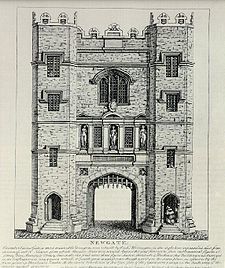 Newgate, the old city gate and prison ~ Wikipedia
Newgate, the old city gate and prison ~ WikipediaMalroy died in prison on 31 July 1485, and he was buried in the Chapel of St. Francis at Grey Friars. Le Morte d'Arthur was published posthumously by William Caxton.
Who was William Caxton?
William Caxton (c.1422 – c.1491) was an Englishman of many talents. He was a merchant, diplomat, translator, writer, and more importantly, William was a printer. William is renowned for bringing the printing press to England. In 1476, William printed his first books.
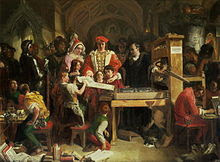 Caxton showing the first specimen of his printing to King Edward IV and Queen Elizabeth at the Almonry, Westminster (painting by Daniel Maclise) ~ Wikipedia
Caxton showing the first specimen of his printing to King Edward IV and Queen Elizabeth at the Almonry, Westminster (painting by Daniel Maclise) ~ WikipediaLe Morte d'Arthur became surprisingly popular and was reprinted many times over the centuries, although sometimes things were added into the works and likewise, things were taken out. Originally Malory umbrellaed eight books under Le Morte d'Arthur, but for some unfathomable reason, Coxton divided the original eight into 21, which makes a staggering 507 chapters!
I often wonder if Malory, while dying in prison, had any idea how influential his work would become.
***
If you fancy finding out what happened after the death of King Arthur then why not check out my historical fantasy series — The Du Lac Chronicles...

Amazon US
Amazon UK
Read for free with

Published on July 12, 2017 23:00
Author’s Inspiration ~ Tim Walker #histfic #Roman @timwalker1666
Please give a warm Coffee Pot welcome to Historical Fiction author, Tim Walker. Tim is going to share with us his inspirations behind his fabulous Dark Age series…
Abandoned!(A Light In The Dark Ages Book 1)
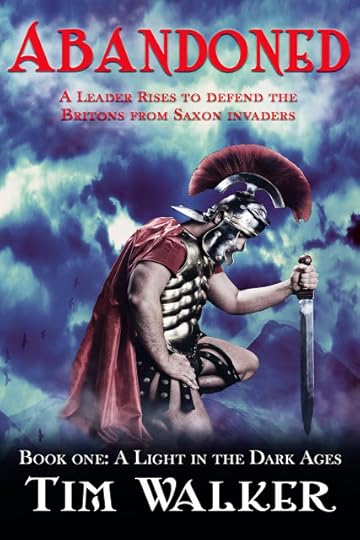
Britannia lies shocked and exposed by the sudden departure of the Roman legions in the year 410. A hero arises - Marcus Aquilius - to protect the town of Calleva from an invading Saxon army. The townsfolk must decide if their town and way of life is worth fighting for, or if they should flee to the forest and revert to a tribal lifestyle. Marcus knows he must embrace change and makes his own personal journey to emerge as Marcus Pendragon.
Ambrosius: Last of the Romans(A Light In The Dark Ages Book 2)

Britannia lies open to barbarian invasions as it slowly adjusts to life after Roman rule. Cruel high king Vortigern has seized control and chosen to employ Saxons in his mercenary army. But who is the master and who the puppet?
Enter Ambrosius Aurelianus, a Roman tribune on a secret mission to Britannia. He is returning to the land where, as a child, he witnessed the murder of his noble father and grew up under the watchful eyes of an adoptive family in the town of Calleva Atrebatum. He is thrown into the politics of the time, as tribal chiefs eye each other with suspicion whilst kept at heel by the high king.
Ambrosius finds that the influence of Rome is fast becoming a distant memory, as Britannia reverts to its Celtic tribal roots. He joins forces with his adoptive brother, Uther Pendragon, and they are guided by their shrewd father, Marcus, as he senses his destiny is to lead the Britons to a more secure future.
Ambrosius: Last of the Romans is an historical fiction novel set in the early Dark Ages, a time of myths and legends that builds to the greatest legend of all – King Arthur and his knights
Author’s InspirationMy latest novel, Ambrosius: Last of the Romans, is the second part in a historical fiction series, A Light in the Dark Ages. It follows on from Abandoned! - the starting point of a three-generation story of a family who must use their wits and skills to survive in post-Roman Britannia in the fifth century. The Romans made an orderly withdrawal from their most northerly province between 409-410 AD, after which the lush island was a magnet to invaders from all sides, precipitating a bloody and destructive slide into a time of fear and anguish.The idea for this story came about during a visit I made to the site of what was once the Roman town of Calleva Atrebatum in Hampshire (later known as Silchester), not far from where I live. The site, maintained by English Heritage, is a square patch of grass surrounded by the remnants of an earth bank. There are no surviving structures on it save for a Christian church added after its mysterious abandonment some years after the Romans departed.
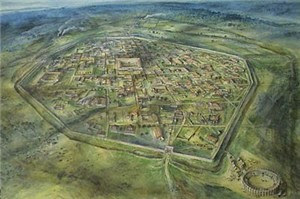 Artist impression of Calleva Atrebatum Standing in this remarkable space amidst grazing cows, I felt history seeping from the very ground beneath me, heard the march of Roman legionary boots on paved roads, cries from a busy marketplace and the clash of swords from across two thousand years. Later, I read that in 1866 excavators discovered a bronze eagle (note: The Silchester Eagle, housed in Reading Museum) buried where the forum would have stood, thought to be the standard of a Roman legion. Who buried it and under what circumstances remain a mystery. This fact inspired me (as it had inspired Rosemary Sutcliffe years before to write The Legion of the Ninth) to weave a sub-plot into Abandoned! My story involves a slave who stole a bronze eagle from his master and hid it on the night before the garrison marched out for the last time.
Artist impression of Calleva Atrebatum Standing in this remarkable space amidst grazing cows, I felt history seeping from the very ground beneath me, heard the march of Roman legionary boots on paved roads, cries from a busy marketplace and the clash of swords from across two thousand years. Later, I read that in 1866 excavators discovered a bronze eagle (note: The Silchester Eagle, housed in Reading Museum) buried where the forum would have stood, thought to be the standard of a Roman legion. Who buried it and under what circumstances remain a mystery. This fact inspired me (as it had inspired Rosemary Sutcliffe years before to write The Legion of the Ninth) to weave a sub-plot into Abandoned! My story involves a slave who stole a bronze eagle from his master and hid it on the night before the garrison marched out for the last time.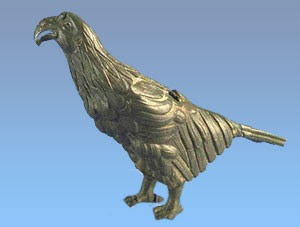 The Silchester Eagle The Romans had defeated the local Briton tribe, the Atrebates, and built their town on the site of an existing settlement from around 50 AD. The conquerors clearly wanted to keep their subjects ‘on side’ and so named their new fortified town after their tribal name, perhaps hinting at a desire for conciliation, assimilation and co-operation. Calleva Atrebatum, literally, the woody place of the Atrebates, was a staging post for legions marching north and west for over three hundred years until one day, around 410 AD, the Roman garrison packed up and marched away, leaving those remaining to organise and defend themselves. Was this viewed as liberation or abandonment by the Britons who remained?The early part of the Dark Ages is a period of myths and legends, most notably of King Arthur and his knights. It is the realm of archaeologists and sleuth-historians looking for clues to what actually happened in a turbulent period during which there was little record keeping; at least little that survived the pillaging and burning of dwellings and places of worship. It was the age of a desperate struggle for survival, wedged between the end of Britain as an orderly Roman province and the growth of Anglo-Saxon kingdoms.Enter Ambrosius Aurelianus, a Roman tribune on a secret mission to Britannia. In my story, he is returning to the land where, as a child, he witnessed the murder of his noble father and grew up under the watchful eyes of an adoptive family in the town of Calleva Atrebatum. He is thrown into the politics of the time, as tribal chiefs eye each other with suspicion whilst kept at heel by the high king. Ambrosius Aurelianus is a real, if dimly observed, early high king of Britannia, mentioned by early historians Gildas, Bede the Venerable and Geoffrey of Monmouth. The precise dates of his reign, details of his life, deeds and where his burial or cremation site lie, remain unknown.
The Silchester Eagle The Romans had defeated the local Briton tribe, the Atrebates, and built their town on the site of an existing settlement from around 50 AD. The conquerors clearly wanted to keep their subjects ‘on side’ and so named their new fortified town after their tribal name, perhaps hinting at a desire for conciliation, assimilation and co-operation. Calleva Atrebatum, literally, the woody place of the Atrebates, was a staging post for legions marching north and west for over three hundred years until one day, around 410 AD, the Roman garrison packed up and marched away, leaving those remaining to organise and defend themselves. Was this viewed as liberation or abandonment by the Britons who remained?The early part of the Dark Ages is a period of myths and legends, most notably of King Arthur and his knights. It is the realm of archaeologists and sleuth-historians looking for clues to what actually happened in a turbulent period during which there was little record keeping; at least little that survived the pillaging and burning of dwellings and places of worship. It was the age of a desperate struggle for survival, wedged between the end of Britain as an orderly Roman province and the growth of Anglo-Saxon kingdoms.Enter Ambrosius Aurelianus, a Roman tribune on a secret mission to Britannia. In my story, he is returning to the land where, as a child, he witnessed the murder of his noble father and grew up under the watchful eyes of an adoptive family in the town of Calleva Atrebatum. He is thrown into the politics of the time, as tribal chiefs eye each other with suspicion whilst kept at heel by the high king. Ambrosius Aurelianus is a real, if dimly observed, early high king of Britannia, mentioned by early historians Gildas, Bede the Venerable and Geoffrey of Monmouth. The precise dates of his reign, details of his life, deeds and where his burial or cremation site lie, remain unknown. Ambrosius Aurelianus
Ambrosius Aurelianus My Ambrosius finds that the influence of Rome is fast becoming a distant memory, as Britannia reverts to its Celtic tribal roots. He joins forces with his adoptive brother, Uther Pendragon, and they are guided by their shrewd father, Marcus, as he senses his destiny is to lead the Britons to a more secure future.
Links for PurchaseAbandoned!(A Light In The Dark Ages Book 1) Amazon
Ambrosius: Last of the Romans(A Light In The Dark Ages Book 2) Amazon
About the author

Tim Walker is an independent multi-genre author based near Windsor, in the UK. This book, Ambrosius: Last of the Romans, is part two in a three-part historical fiction series under the series title, A Light in the Dark Ages. Part one, Abandoned!is available from Amazon, with part three, Uther’s Destiny, soon to follow.
He has also written and published a children’s book, The Adventures of Charly Holmes, co-authored with his daughter, Cathy; a book of short stories, Thames Valley Tales, and a dystopian thriller, Devil Gate Dawn.Useful LinksWebsiteAmazon Author PageFacebook Twitter
Published on July 12, 2017 00:00
July 10, 2017
Guest Post ~ Erika M Szabo #Hungarian #myths #legends @MultiGenreBooks
I am handing the blog over today to fantasy / children’s author, Erika M Szabo. Erika is going to introduce us to Hungarian mythology. So, take it away, Erika…!

Click on the link below to find out about Erika's books....
Golden Box Book Publishing
I grew up in a small town in Hungary. When I was a young child we didn’t live in a virtual world. I didn’t text my friends, we talked. I didn’t play computer games, and I was allowed to watch TV only one hour a day.
Let me tell you, I didn’t miss out on anything.
I had real and not virtual friends to play with. I learned about nature while helping grandma to weed the garden or while we collected herbs in the woods.
In the evenings I loved listening to my old neighbour’s stories. He introduced me to old legends that were passed down to younger generations by the elders.
I added some of the Hun legends, that I learned as a child and later researched, to my magical realism, fantasy story, The Ancestors’ Secrets Series.
The Legend of the White Stag
(A Feher Szarvas Legendaja)

TrianonTruth
Protected by the Falcon

Book Extract
Elza gave me her present last. It was a thin, delicately woven black string with an inch in diameter thick gold pendant that was not perfectly round. The magnificent Turul bird with widely stretched wings was so detailed on the pendant that it took my breath away.
“Your mother asked me to give this to you on your birthday, if she… when she…” Elza choked the words out.
“I remember this necklace. Mom showed it to me on my ninth birthday,” I said, misty-eyed. It was exquisite, and I knew it must have been about as old as my flute. I stared at it astounded and wondered how many of my ancestors wore it around their necks.
“I made the chain from the hairs of Midnight’s tail when you were four or five.” Rua smiled.
“It is so delicate, thank you, Rua. I loved that horse.”
I put the necklace on and fingered the smooth medallion. It instantly warmed to the temperature of my skin. Suddenly, I felt Mom’s strong presence and tears welled up in my eyes. I felt her protective love deep within me.
We sat on the patio for a little while more, enjoying the autumn sun and enjoying our togetherness. We were telling stories of previous birthdays and remembered our loved ones who were long gone. We watched Tui and Gypsy exploring the bushes and digging for moles. Gypsy glanced at Rua from time to time as if checking whether it was okay for him to dig. Rua didn’t move or say anything; he just let the two dogs enjoy themselves, which they did. Later, they took a doggy nap in the shade on the patio while Rua told the legend of the great stag.
Wondrous-headed doe with hornsof a thousand branches and knobs.Thousand branches and knobsand of a thousand bright candles.Among its horns, it carriesthe light of the blessed sun.On its forehead, there is a star,on its chest the moon.And it starts along the banksof the shining heavenly Danube,That it may be the messengerof heaven and bringer of news,About our creator and caring God.
I always loved this legend. It was difficult to see the meaning of the legend behind all the symbolism, but when Dad had explained it once, it made some sense to me. He said, “The cosmos, the mother of the sun, is represented by a female horned doe, or hind. Being a symbol of the cosmos, she also carried the stars representing the people united. Just as the cosmos was her mother, she was the mother of the stag who symbolized the sun.”
“Rua, you’ve been telling us stories, but I never heard you mention anything about the four hundreds,” inquired Ema.
“There are many speculations, but nothing is known for certain. The legend says those were dark and uncertain times and that we might never find out what happened back then,” Ema frowned, “Oh, you and your legends. Never a straight answer to anything.”
“I just tell the legends as my father before me.”
Ema sighed, annoyed, and started playing with the CD player. To match her mood, she chose Brahms, and drummed the tune on her knees. Bela begged her to switch to Chopin, and when she did, everyone settled into a lazy mode. We listened to the music and enjoyed the beautiful late afternoon.
“Tell us more stories Rua,” begged Ema, turning to him.
“Okay, I’ll tell you a story about King Matyas.” Rua said as he sipped his coffee.
We all leaned back, ready for the tale. I always loved his stories about the wise and just king, but Ema cut him off before he could start the story, “But Rua, you told us all the stories about King Matyas already. Tell us why the falcon is so important in our history.”
“Well, according to the legend, the Turul is a messenger of the Creator. It sits on top of the tree of life along with the spirits of unborn children in the form of birds. When we are in need, the Turul stretches its wings over us, guides and protects us.”
Ema’s eyes turned sad and looked away, “It doesn’t protect everyone.”“That’s true. It doesn’t protect individual people from life’s everyday cruelty. It protects us as a nation, all of us. Also, the Turul bird’s role is to protect the sword that appoints the King or Queen, who are proven to be worthy.”
“How can a mythical bird do that?”
“I don’t know, but the legend says that when the time is right and the person is chosen, they hear the falcon’s victory cry and the flaming sword mark appear on their neck with the symbol of the King or Queen on their face.”
Ema sighed and shrugged her shoulders, “Oh, Rua, these are just legends.”
“Well, there is a small truth, somewhere, in every tale that’s told. Maybe it’s just a legend. There was not a Hun who had the mark since the fourteen hundreds, so we can’t say if it’s true or just a myth.”
“Having a King or Queen is nothing but a show and symbolic representation nowadays. They don’t have the power to rule a nation like the ancestors.” Ema replied.
“That’s true…” Rua looked at Elza who touched his hand to warn him, and he didn’t finish the sentence.
Noticing the interaction, I said, “Elza please let him finish.”
Rua smiled, “There is nothing more to say. These are just legends.”I had a feeling that we were not going to find out more from either of them. We started talking about Ema’s art show and Bela talked about his new book for a while, but soon I was itching to be alone. Bela probably sensed my mood and did not linger. He left with Tui cuddled to his chest. At first, she protested at being taken away so suddenly, but soon she was yelping good-bye to Gypsy. Ema had a new idea for a painting and quickly disappeared into her studio. Elza said she had a new recipe to try for dinner and retreated into the kitchen.
I followed her, because the comment she had made was eating at me and couldn’t rest until I found out more. “Elza, what is this mystery you can’t tell us about? Please tell me,” I begged.
“I knew you wouldn’t stop. You’re like a bulldog; sink your teeth in and won’t let go. You won’t find out more from me, so drop it.”
“No, I’m not going to drop it. You have to tell me more. Why did my mother tell me I have a birthright?”
“I would tell you if I could, believe me. I’ve said too much already. Your mother was the only one who could have told you about it.” She stared at me, pained and apologetic.
“Why can’t you tell me?”
Universal Purchase Link
Thank you so much Erika, for sharing The Legend of the White Stag with us!
Published on July 10, 2017 23:00
July 9, 2017
Sale ~ The Du Lac Chronicles is only 0.99 on #Kindle #Arthurian #HistFic #ASMSG
I have great news, The Du Lac Chronicles is only 0.99 on Kindle for a Limited Time only ~ Don’t miss out!
[image error]
“I am a fan of all things King Arthur, and have read numerous versions of the legend. This one is a new take on the story that is simply brilliant!”
A generation after Arthur Pendragon ruled, Briton lies fragmented into warring kingdoms and principalities.
Eighteen-year-old Alden du Lac ruled the tiny kingdom of Cerniw. Now he half-hangs from a wooden pole, his back lashed into a mass of bloody welts exposed to the cold of a cruel winter night. He’s to be executed come daybreak—should he survive that long.
When Alden notices the shadowy figure approaching, he assumes death has come to end his pain. Instead, the daughter of his enemy, Cerdic of Wessex, frees and hides him, her motives unclear.
Annis has loved Alden since his ill-fated marriage to her Saxon cousin—a marriage that ended in blood and guilt—and she would give anything to protect him. Annis’s rescue of Alden traps them between a brutal Saxon king and Alden’s remaining allies. Meanwhile, unknown forces are carefully manipulating the ruins of Arthur’s legacy.
Cranky The Book Curmudgeon ~ The Du Lac Chronicles book review
Book Excerpt
[image error]
AD 495 Wessex, Briton.
Alden du Lac drew in a ragged breath. The cold night air hurt his lungs, and the rough wooden post that he was tied to rubbed the wounds on his back. He had prayed for the welcomed relief of unconsciousness; alas, it was not to be. It seemed even God wanted him to suffer for his failings.
He had lost count how many times he had been lashed. All he knew was that each lash represented every Wessex soldier that had been killed by his men. Cerniw's losses had been far higher, but no one paid for their deaths. Life was never fair, though; he did not need a lost battle and hundreds dead to tell him that much.
The year had been horrendous. Cerniw, with its rugged moorlands, its vast forests and beautiful coasts, had been struck with one pestilence after another. The people started to talk about moving, and some already had. Those who had stayed loyal to the land and, of course, to him, no doubt now wished they had not, for when Cerdic's Saxons came, they purged the kingdom, making it look like the hell the bishop preached of in his Sunday sermon. Alden, unlike God, had been powerless to do anything about it. Oh yes, he had fought, but the numbers he fought against had overwhelmed his army, for who could fight the devil, without God on their side, and think to win? Alden hung his head in shame, his shoulder-length dark hair falling into his face. He cursed his naivety and worse still, his arrogance. His younger brother had warned him, but he had not heeded the warning; instead, he believed the useless treaty that Cerdic of Wessex had offered him only months before. He should have seen where Cerdic was going with it then, only he had been blinded by grief, by guilt. The responsibility for what happened, therefore, was his and his alone. He knew that, and he took the blame. He deserved to be tied to a post waiting for death. Alden closed his pain-filled grey eyes as the image of his homeland in flames scorched his mind. He could hear the screams, the begging for mercy, and the cries for help. He could taste the terror in the air and feel the heat of the flames. Dear God, what had he done?
He had been left with no alternative. Even now, with the clarity of hindsight, he could see no other choice. He had ridden towards the enemy, carrying the white flag of truce and hoping ⎯ sweet Lord, how he had hoped ⎯ for clemency, not for himself, but for his people.
Instead, Cerdic's soldiers had pulled him unceremoniously from his horse and taken him prisoner along with at least eighty of his kinsmen. Of their fate he was uncertain, but his was assured. If he did not die tonight from exposure then an axe awaited him at dawn. It was a terrifying thought, and he prayed to God for courage. He felt no warm, welcoming presence and he feared what all men secretly feared, that on the morrow, he would not die well.
Snow began to fall softly from the night sky, not enough to settle, just enough to plummet the temperature further. He began to shiver. He tried thinking of a warm fire and his large bed covered in thick furs. It did not help. After all, when last he saw his fort it was in flames.
“Are you still alive, du Lac?”
Alden kept his head down, pretending to be unconscious, and hoped the bastard would leave him alone to die in peace.
Draca, the guard in charge of the prisoners, was not fooled. He lived for terror and he had no intention of allowing the former ruler of Cerniw an easy death. He grabbed Alden's chin roughly and forced his head up.
Alden opened his eyes and stared with contempt at the soldier in front of him. Draca was a huge man, with a shiny bald head, tiny eyes and a big fist, whose breath stank of stale beer and his body of gone-off fish mixed horribly with the smell of fresh blood ⎯ not his own, but someone else's.
“Not quite dead yet, are you? Won't be long, though.” Draca chuckled deep in his throat. “I've never killed a King before. I'm looking forward to it…”
Links for purchase

Amazon US
Amazon UK
Also available in paperback.

Published on July 09, 2017 23:00
July 6, 2017
Book Spotlight ~ Killer of Kings #HistoricalFiction @MatthewHarffy
Killer of Kings
(Book four of the Bernicia Chronicles)
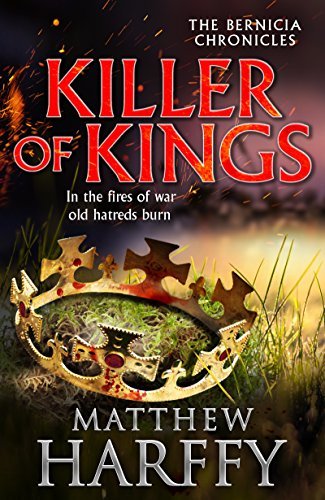
AD 636. Anglo-Saxon Britain. A gripping, action-packed historical thriller and the fourth instalment in The Bernicia Chronicles. Perfect for fans of Bernard Cornwell.
Beobrand has land, men and riches. He should be content. And yet he cannot find peace until his enemies are food for the ravens. But before Beobrand can embark on his bloodfeud, King Oswald orders him southward, to escort holy men bearing sacred relics.
When Penda of Mercia marches a warhost into the southern kingdoms, Beobrand and his men are thrown into the midst of the conflict. Beobrand soon finds himself fighting for his life and his honour.
In the chaos that grips the south, dark secrets are exposed, bringing into question much that Beobrand had believed true. Can he unearth the answers and exact the vengeance he craves? Or will the blood-price prove too high, even for a warrior of his battle-fame and skill?
Links for PurchaseKiller of Kings
About the author

Matthew Harffy lived in Northumberland as a child and the area had a great impact on him. The rugged terrain, ruined castles and rocky coastline made it easy to imagine the past. Decades later, a documentary about Northumbria's Golden Age sowed the kernel of an idea for a series of historical fiction novels. The first of them is the action-packed tale of vengeance and coming of age, THE SERPENT SWORD.
Matthew has worked in the IT industry, where he spent all day writing and editing, just not the words that most interested him. Prior to that he worked in Spain as an English teacher and translator. Matthew lives in Wiltshire, England, with his wife and their two daughters.Useful LinksWebsiteFacebook
Published on July 06, 2017 23:00
July 5, 2017
The Hallelujah Victory ~ #FolkloreThursday #Britain #history
Britannia's very foundation is built on stories. Over time some of these stories have been forgotten, which I think is a crying shame. If you are a regular reader of this blog, you will know that my particular interest is in Arthurian legend, but I wanted to cast my net a little bit wider and have a look at a very intriguing battle that is aptly named...
'The Hallelujah Victory.'
What was happening in Britain at the end of Roman Occupation?
Britain was, with a few exceptions, under Roman rule from 43ADc. to 410. However, by the end of the 4th Century, The Roman Empire had run into some problems. I am not going to go into what problems they were today, as this would take up several posts, but what I will say is they found themselves in a position where they did not have enough troops to defend Britain from the ever increasing barbarian attacks.

To cut a very long story short, the Roman's abandoned their posts and withdrew from the island. Briton was alone. She now had to look to herself to defend her borders.
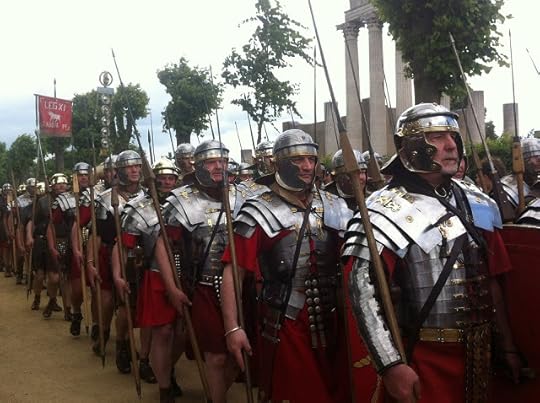
What Briton needed was a saviour. A hero. They found one in Germanus of Auxerre.
Who was Germanus of Auxerre and why did he travel to Britain?
 Germanus, Bishop of Auxerre
Germanus, Bishop of Auxerre Around 429 a Gaulish Assembly of Bishops met, and they discussed a very concerning matter. They had heard a troubling rumour that Pelagianism was rife in the British clergy and that would never do. They sent Germanus of Auxerre, Bishop of Auxerre, and Lupus, Bishop of Troyes, to pay a visit to these rebellious islanders. When they reached Britain, Germanus and Lupus confronted the British clergy in an open meeting. They were disgusted by what they saw, but with a careful rhetorical argument, Germanus saved the day and steered Britain away from Pelagianism and back onto the correct and righteous path.
But that wasn't all that Germanus did.
Britain had been an occupied country for a long time. They had spent many years under the protection of the Roman Army. But there was no Roman Army in Britain anymore. The Picts and the Scots were not ones to miss an opportunity. They crossed over the Wall, that the Romans' had once so diligently guarded, and invaded. They killed, pillaged and burnt. The Britons were beside themselves. How were they going to defeat such a military might? Rome certainly wasn't going to come to their aid. In desperation, they asked Germanus for help.
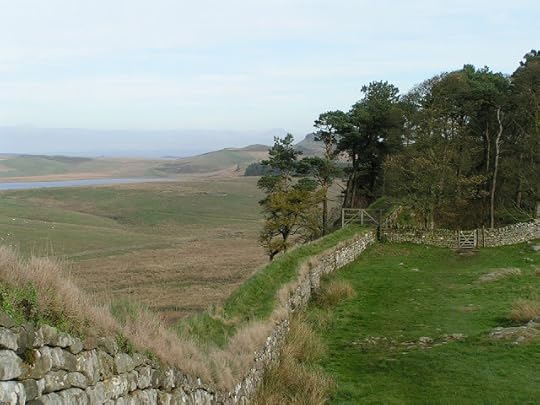 Hadrian's Wall.
Hadrian's Wall.Germanus to the rescue.
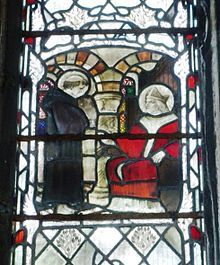 Stained glass window at Gloucester Cathedral depicting St Patrick being taught by St Germanus
Stained glass window at Gloucester Cathedral depicting St Patrick being taught by St GermanusGermanus, ever confident, told the people of Briton to do exactly as he told them, and all would be well. Germanus meant what he said. He not only had God on his side, but he was also a highly educated man. He had studied eloquence and civil law in Rome. Before he entered the Church, he had held very high offices in government. He knew what he was talking about.
Germanus picked his battleground carefully. He said the only way they could beat the barbarians was by having the higher ground. He found the perfect location — it was a remote, mountainous site near a river. He told his small army to climb the mountains and spread out over the three sides of the valley. This they did.
The Picts and Scots confidently rode into the valley. They thought this would be an easy win. Were they in for a surprise!
An arrow shot across the sky. This was the signal Germanus' men had been waiting for. Germanus yelled...
"Hallelujah! Hallelujah! Hallelujah!"
His army took up the cry. The sound of their voices echoed off the mountain walls. The Picts and Scots were deafened by a noise of what sounded like thousands of men.
"Hallelujah!" the army of Germanus yelled.
"Hallelujah!" they yelled again.
Fearing that they were about to be slaughtered by the largest army that had ever been assembled, the Picts and Scots dropped their weapons, turned around and fled.
The Britons were victorious. Germanus sent the Barbarians home without one drop of blood being shed. Quite an achievement in anyone’s book!
So there were have it, The Hallelujah Victory.
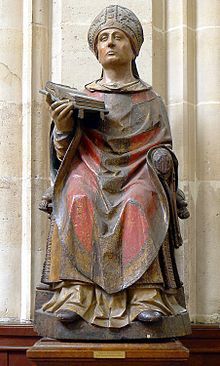 Saint Germain l'Auxerrois statue
Saint Germain l'Auxerrois statueThe site of the bloodless battle is in a place now named Maes Garmon in Flintshire, North Wales. The name simply means "The Field of Germanus."
*All images are in the Public Domain.*
If you fancy finding out what happened after the death of King Arthur then why not check out my historical fantasy series — The Du Lac Chronicles...

Amazon US
Amazon UK
Read for free with

Published on July 05, 2017 23:00
The Coffee Pot Book Club
The Coffee Pot Book Club (formally Myths, Legends, Books, and Coffee Pots) was founded in 2015. Our goal was to create a platform that would help Historical Fiction, Historical Romance and Historical
The Coffee Pot Book Club (formally Myths, Legends, Books, and Coffee Pots) was founded in 2015. Our goal was to create a platform that would help Historical Fiction, Historical Romance and Historical Fantasy authors promote their books and find that sometimes elusive audience. The Coffee Pot Book Club soon became the place for readers to meet new authors (both traditionally published and independently) and discover their fabulous books.
...more
...more
- Mary Anne Yarde's profile
- 159 followers



